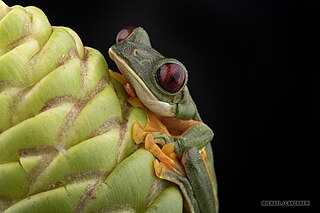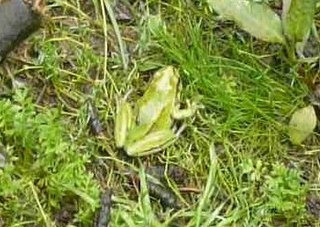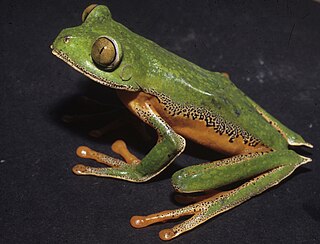
Agalychnis callidryas, commonly known as the red-eyed tree frog, is a species of frog in the subfamily Phyllomedusinae. It is native to forests from Central America to north-western South America. This species is known for its bright coloration, namely its vibrant green body with blue and yellow stripes on the side. It has a white underside, brightly red and orange colored feet, and is named after its distinctive bright red eyes.

The blue-sided leaf frog, also known as the orange-eyed leaf frog, is an endangered species of tree frog in the subfamily Phyllomedusinae native to the tropical rainforests of Costa Rica and Panama. The specific name annae honors Ann S. Duellman, the collector of the holotype and the describer's wife.

The Pine Barrens tree frog is a species of New World tree frog. It is becoming rare due to habitat loss.

The plateau tiger salamander or Mexican tiger salamander is a species of mole salamander in the family Ambystomatidae. It is typically considered endemic to Mexico, although its range might extend to the United States. Its natural habitat is grassland, including sparse forest and semiarid grassland. Breeding takes place in a range of aquatic habitats: deep volcanic lakes, shallow vernal pools, artificial cattle ponds, and intermittent, fish-free stream pools. It exhibits facultative paedomorphosis.

Morelet's tree frog, also known as black-eyed leaf frog and popeye hyla, is a species of frog in the subfamily Phyllomedusinae. It is found in Belize, El Salvador, Guatemala, Honduras, and Mexico.

Agalychnis saltator, also known as the parachuting red-eyed leaf frog and misfit leaf frog, is a species of frog in the subfamily Phyllomedusinae. It is found in the Caribbean lowlands from north-eastern Honduras to eastern-central Costa Rica at elevations of 15–1,300 m (49–4,265 ft) asl.

The gliding tree frog is a species of frog in the subfamily Phyllomedusinae. It is found in Colombia, Costa Rica, Ecuador, and Panama. Other common names are the gliding leaf frog, Spurrell's leaf frog, and pink-sided tree frog. The specific name, spurrelli, is in honour of British zoologist Herbert George Flaxman Spurrell.

The ridged tree frog is a species of frog in the family Hylidae endemic to Mexico. Its natural habitats include mountainous pine-fir forests in high elevations. In lower elevations it is known to inhabit moderate and low-lying streams and ponds where it is believed to breed.

Hylomantis aspera is a species of frog in the subfamily Phyllomedusinae. It is endemic to Brazil. Its natural habitats are subtropical or tropical moist lowland forests, swamps, and intermittent freshwater marshes. It is threatened by habitat loss.

Agalychnis danieli, also known as the Antioquia leaf frog, is a species of frog in the subfamily Phyllomedusinae. It is endemic to Colombia and only known from its type locality in the northern part of the western flank of the Cordillera Occidental in the Antioquia Department. The specific name danieli honours Brother Daniel Gonzales Patiño, a Colombian monk with naturalist inclinations who became the director of Natural History Museum of the Instituto de La Salle, Bogotá.
Hylomantis granulosa, also known as the granular leaf frog, is a species of frog in the subfamily Phyllomedusinae. It is endemic to eastern Brazil where it is only known from Amargosa, Bahia, and Recife; the type locality is the Zoo Botanical Park Dois Irmãos in Recife. Its natural habitats are lowland forests, including secondary forests. Breeding takes place in streams. Threats to this species are related to habitat loss.

Agalychnis hulli is a species of frog in the subfamily Phyllomedusinae. It is found in north-eastern Peru and in adjacent regions of Ecuador.

Agalychnis lemur, the lemur leaf frog or lemur frog, is a species of frog in the subfamily Phyllomedusinae. It is found in Costa Rica, Panama, and adjacent northwestern Colombia. It is classed as Critically Endangered and threatened by the fungal disease chytridiomycosis.
Agalychnis medinai, also known as the Rancho Grande leaf frog, is a species of frog in the subfamily Phyllomedusinae. It is endemic to the central part of the Venezuelan Coastal Range.

Agalychnis psilopygion is a species of frog in the subfamily Phyllomedusinae. It is found in southern Colombia and north-western Ecuador. Its natural habitats are subtropical or tropical moist lowland forests, rivers, freshwater marshes, and intermittent freshwater marshes. It is threatened by habitat loss.

Afrixalus fornasini is a species of frog in the family Hyperoliidae and is native to Africa. Its common name is Fornasini's spiny reed frog or the greater leaf-folding frog

The Natal banana frog also known as the Natal Leaf-folding Frog is a species of frog in the family Hyperoliidae. It is found in South Africa and possibly Lesotho. Its natural habitats are temperate forests, temperate shrubland, swamps, intermittent freshwater marshes, arable land, rural gardens, ponds, and canals and ditches. It is threatened by habitat loss.
The Central Asiatic frog, or Asian frog, is a species of true frog, found in China, Kazakhstan, and Kyrgyzstan. Its natural habitats are temperate forests, temperate shrubland, temperate grassland, rivers, intermittent rivers, swamps, freshwater lakes, intermittent freshwater lakes, freshwater marshes, intermittent freshwater marshes, freshwater springs, inland deltas, arable land, pastureland, rural gardens, urban areas, water storage areas, ponds, aquaculture ponds, and irrigated land. It is not considered threatened by the IUCN.

Polypedates leucomystax is a species in the shrub frog family Rhacophoridae. It is known under numerous common names, including common tree frog, four-lined tree frog, golden tree frog or striped tree frog. Many past authors have united it with the common Indian tree frog in P. maculatus, but today they are generally considered distinct species. In its native range, it is also called "white-lipped tree frog", but this name is otherwise applied to a species of true tree frogs.
Agalychnis terranova is a species of frog endemic to Colombia. It has been observed between 240 and 900 meters above sea level.

















